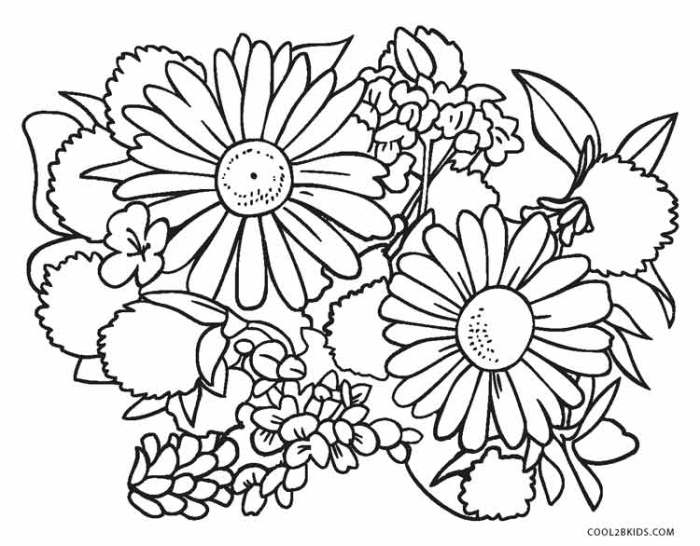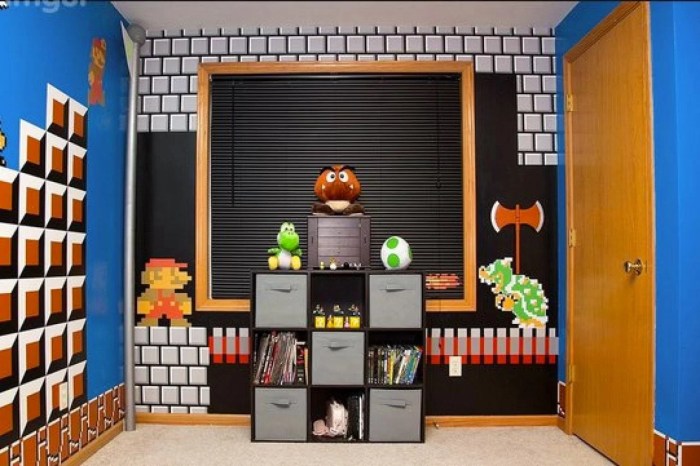Flower Variety & Design
Printable coloring pages for kids flowers – This section details the design considerations for creating printable coloring pages featuring a variety of flower types and styles, focusing on petal shapes, leaf structures, stem variations, and artistic stylization techniques. The goal is to provide detailed descriptions that can be used as a guide for creating engaging and educational coloring pages for children.
Realistic Flower Designs
Five distinct coloring page designs are presented below, each showcasing a different flower type. These designs emphasize realistic representation of the flowers’ botanical features.
- Roses: The coloring page features a single, fully bloomed rose. Petals are depicted as overlapping, slightly rounded shapes with subtle curves and variations in size. The leaves are serrated, with a prominent central vein and smaller secondary veins branching out. The stem is shown as a thick, slightly curved line with small thorns subtly indicated.
- Sunflowers: This design shows a large sunflower head with numerous small, closely packed petals radiating outwards from a central disc. The petals are elongated and slightly curved, with a subtle tapering towards the tip. Large, heart-shaped leaves with serrated edges are attached to a thick, sturdy stem.
- Tulips: A single tulip is depicted, focusing on its characteristic cup-shaped flower. The petals are smooth, ovate shapes, meeting at the base to form a closed cup. Long, slender leaves emerge from the base of the stem, which is shown as a straight, relatively thin line.
- Daisies: This design features a daisy with a central yellow disc surrounded by numerous white petals. The petals are slender, slightly elongated, and arranged in a radiating pattern. The leaves are oblong, with slightly serrated edges and are attached to a thin stem.
- Lilies: The coloring page displays a single lily with six tepals (petal-like structures) that curve gently outward. The tepals are broad at the base and taper slightly towards the tips. Long, lanceolate leaves emerge alternately along a relatively thick stem.
Stylized Flower Designs
Three different stylized flower designs are described below, emphasizing creative interpretation rather than strict botanical accuracy.
- Cartoonish Flowers: This design employs simple, rounded shapes and exaggerated features to create a whimsical feel. Petals are large, rounded, and often overlapping, with minimal detail. Leaves are simple, oval shapes. Stems are thin and wavy. The overall effect is playful and child-friendly.
- Geometric Floral Patterns: This design uses geometric shapes, such as triangles, squares, and circles, to create a flower pattern. Petals are formed using these shapes, creating a structured and modern look. Leaves are simplified geometric forms, and stems are straight lines. The design allows for creative exploration of geometric combinations.
- Abstract Flowers: This design features flowers represented through abstract shapes and colors. Petals might be represented by swirling lines or irregular shapes. Leaves and stems are similarly abstract, focusing on the overall visual impact rather than realistic representation. This design encourages children to explore their creativity with color and shape.
Flower Bouquet Design
A visually appealing bouquet design incorporates several different flower types arranged in a pleasing manner. The arrangement uses a variety of heights and shapes to create visual interest. Taller flowers, such as lilies or sunflowers, are placed towards the center and back, with shorter flowers, such as tulips and daisies, positioned towards the front. The overall shape of the bouquet is somewhat rounded, creating a balanced and harmonious composition.
The stems are arranged to create a natural, flowing look, avoiding rigid lines. The color palette can be chosen to enhance the visual appeal, perhaps using contrasting or complementary colors to create a vibrant effect.
Age Appropriateness & Complexity

Designing coloring pages for children requires careful consideration of age-appropriate complexity. Visual elements, detail levels, and the overall design should align with a child’s developmental stage, ensuring both engagement and a manageable challenge. This ensures the activity remains enjoyable and fosters a sense of accomplishment.The following sections detail design considerations and examples of coloring pages suitable for different age groups, focusing on the principles of simplicity, progressive complexity, and age-related cognitive abilities.
Coloring Pages for Toddlers (Ages 2-3), Printable coloring pages for kids flowers
Toddlers benefit from large, simple shapes and bold Artikels. Fine motor skills are still developing, so intricate details can be frustrating. Color choices should be limited to a few primary colors to keep the focus on the act of coloring itself.
- Page 1: Large, single flower with a bold stem. The flower could be a simple circle with large, petal-like shapes attached. The stem would be a thick, straight line. This design emphasizes basic shapes and large color areas.
- Page 2: A cluster of three simple flowers. Each flower could be a different primary color (red, yellow, blue) and a simple shape (circle, square, triangle). The flowers are grouped closely together, encouraging color exploration.
- Page 3: A single, large sun-like flower. The flower is represented as a large yellow circle with simple triangular rays extending outward. This design focuses on a single, easily recognizable shape with minimal details.
Coloring Pages for Preschoolers (Ages 4-5)
Preschoolers are developing their fine motor skills and visual-spatial reasoning. Coloring pages for this age group can incorporate slightly more intricate details, smaller elements, and a wider range of shapes. The designs should still be relatively simple to avoid frustration.
- Page 1: A flower with multiple petals and a defined center. The petals could be slightly more varied in shape and size, and the center could be a contrasting color or a simple pattern.
- Page 2: Two flowers connected by a vine. This introduces a simple concept of interconnectedness and allows for exploration of different colors and patterns on each flower.
- Page 3: A flower in a simple pot. This adds a contextual element to the design and allows for the inclusion of additional shapes and details, such as leaves or simple decorative elements on the pot.
Coloring Pages for Older Children (Ages 6-8)
Older children have developed significantly better fine motor skills and can handle more complex designs. Coloring pages for this age group should incorporate smaller elements, intricate details, and potentially hidden images within the larger design. This challenges their dexterity and problem-solving skills.
So, you’re looking for printable coloring pages for kids flowers? Awesome! But let’s be real, sometimes you need that extra oomph, right? That’s where the superior pigmentation of crayola coloring pages for kids comes in handy. Seriously, those colors are next level. But hey, back to those flower coloring pages – get ready for some seriously vibrant petals!
- Page 1: A highly detailed flower with many petals, leaves, and a complex center. This could include variations in petal shapes and sizes, intricate leaf patterns, and a detailed center with small elements.
- Page 2: A flower with a hidden image within its petals. The hidden image could be a simple shape or object that requires careful observation to identify. This encourages close attention to detail.
- Page 3: A bouquet of flowers with varying levels of complexity. This allows children to choose their level of challenge within a single page, with some flowers being more detailed than others.
Additional Elements & Themes

Enhancing the basic flower coloring pages with additional elements and thematic approaches increases their engagement and educational value. By incorporating interactive elements like insects and varying environmental contexts, children can develop a more comprehensive understanding of the flower’s role within its ecosystem and its aesthetic presentation in different settings. Thematic approaches further engage children by allowing them to explore specific botanical concepts or seasonal variations.Adding interactive elements and thematic approaches provides opportunities for children to learn about nature and art simultaneously.
The incorporation of butterflies, bees, and various environmental settings fosters creativity and allows children to explore their understanding of plant-insect interactions and the diverse habitats where flowers thrive. Thematic approaches encourage exploration of specific floral types and their seasonal contexts.
Butterflies and Bees Interacting with Flowers
Three coloring page designs featuring butterflies and bees interacting with flowers are presented below. The placement and design of these elements are crucial to creating visually appealing and engaging pages.
- Page 1: Daisy and Butterfly. A large daisy dominates the center of the page. A butterfly, with intricate wing details, is positioned delicately landing on one of the petals. The butterfly’s body is slightly curved to emphasize its interaction with the flower. Smaller daisies are scattered around the main flower, creating a sense of a small meadow.
- Page 2: Sunflower and Bee. A large sunflower fills most of the page. A bee, with clearly defined stripes and hairy body, is depicted actively collecting pollen from the sunflower’s center. The bee is positioned slightly off-center, creating visual balance. Smaller sunflowers surround the main flower, offering additional coloring opportunities.
- Page 3: Tulip and Multiple Butterflies. Three tulips of varying colors are clustered together. Several smaller butterflies, each with unique wing patterns, flutter around the tulips, some landing gently on the petals, others in flight nearby. This design emphasizes the dynamic interaction between insects and flowers.
Flowers in Different Settings
The background significantly influences the overall aesthetic and thematic context of the flower coloring pages. The following designs demonstrate the impact of different settings.
- Page 1: Garden Setting. Roses are the focal point, placed centrally amidst a detailed background of a well-kept garden. The background includes small, neatly arranged flowerbeds, a garden fence, and a small birdhouse. The design suggests a calm and organized environment.
- Page 2: Vase Setting. A bouquet of lilies is depicted in a classic vase on a table. The background features a simple, textured wall, perhaps with a subtle pattern. The focus is on the arrangement of the flowers and the vase itself.
- Page 3: Meadow Setting. Wildflowers, such as poppies and daisies, are scattered across the page, set against a background of rolling green hills. The background includes other wildflowers, long grasses, and possibly a distant tree line. The design conveys a sense of freedom and natural abundance.
Thematic Series: Spring Flowers
This series focuses on flowers commonly associated with springtime, highlighting their unique characteristics and vibrant colors.
- Page 1: Tulips. Several tulips in various colors (red, yellow, pink, purple) are arranged in a cluster. The background is a simple light green, suggesting new spring growth. The design emphasizes the shape and color variations of tulips.
- Page 2: Daffodils. A group of daffodils, with their characteristic trumpet-shaped blooms, are shown in a field. The background includes other spring flowers and bright green grass, symbolizing the energy of the season.
- Page 3: Hyacinths. A cluster of hyacinths, known for their dense, fragrant blooms, is featured. The background features subtle spring leaves and soft pastel tones, reflecting the delicate nature of the flower.
Questions Often Asked: Printable Coloring Pages For Kids Flowers
What kind of paper is best for these coloring pages?
Cardstock or heavier weight paper is ideal to prevent bleed-through, especially with markers or watercolors.
Can I use these coloring pages for commercial purposes?
No, these coloring pages are for personal use only. Commercial use requires explicit permission.
Are there any coloring pages suitable for children with special needs?
Yes, the simpler designs aimed at toddlers could be particularly beneficial for children with fine motor skill challenges.
Where can I find the printable PDF?
The PDF will be provided [Insert Link/Instructions Here].



